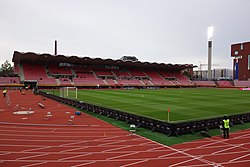| Football in Finland | |
|---|---|
 Helsinki Olympic Stadium, the national stadium of Finland | |
| Country | Finland |
| Governing body | Football Association of Finland (Finnish: Suomen Palloliitto) |
| National teams | Men's national team Women's national team |
| Nicknames | Huuhkajat; Helmarit |
| First played | at least 1890s (men); at least 1970s |
| Registered players | 1907 |
| National competitions | |
| Club competitions | |
League: Tier 1: Veikkausliiga (m), Kansallinen Liiga (w) Tier 2: Ykkösliiga (m), Naisten Ykkönen (w) Tier 3: Ykkönen (m), Naisten Kakkonen (w) Tier 4: Kakkonen (m), Naisten Kolmonen (w) Tier 5: Kolmonen (m), Naisten Nelonen (w) Tier 6: Nelonen (m), Naisten Vitonen (w) Tier 7: Vitonen (m) Tier 8: Kutonen (m) Tier 9: Seiska (m) Cups: Finnish Cup (m) Finnish Women's Cup (w) | |
| International competitions | |
Football in Finland is not, or at least has traditionally not been, the most popular spectator sport, which is in contrast to most European countries; it falls behind ice hockey, which enjoys a huge amount of popularity in the country. [1] Football tops ice hockey in the number of registered players (115,000 vs. 60,000 [2] [3] ) and as a popular hobby (160,000 vs. 90,000 among adults and 230,000 vs. 105,000 among youths [4] [5] ). It is the most popular hobby among 3-18 year olds, whereas ice hockey is 9th. [5] Around 2 million people in Finland, or 45% of the population, are considered football fans. [6]
Contents
- History
- Domestic club competitions
- National teams
- Åland Islands
- Football stadiums in Finland
- Most successful clubs overall
- References
- External links
Football's standing is constantly increasing, especially among girls and women, where the yearly growth rate has lately been over 10 percent. [7] In season 2006–07 19.9 percent of registered players were female. [7] The Football Association of Finland (Finnish : Suomen Palloliitto) has approximately one thousand member clubs. [2] According to a Gallup poll, nearly 400,000 people include football among their hobbies. [4] [5]







